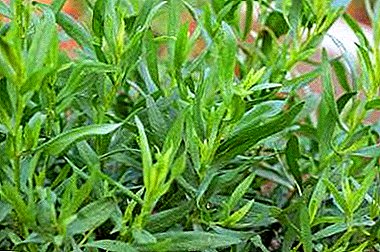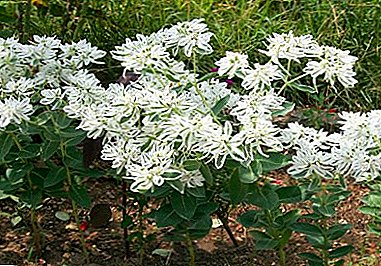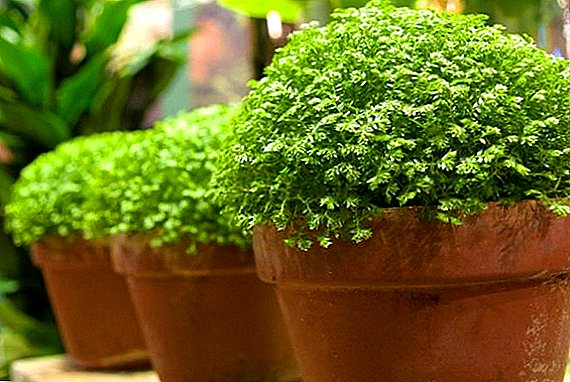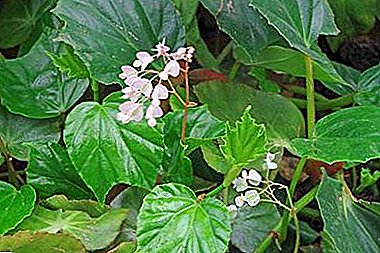
Estragon is a spicy plant. Since ancient times, it is known for its medicinal and taste properties, but in everyday life, Russian housewives will meet him not so often.
And this is unfair, because the list of useful properties of this plant takes up a whole page. Most of all we know him by the name of the drink of the same name - Estragon.
Consider where you can use tarragon in medicine, why it is used for weight loss, where to add grass in fresh or dried form in cooking, with which it is combined.
Taste and aroma of tarragon
Estragon belongs to the genus Wormwood, which in our perception is strongly associated with bitter taste. However, tarragon stands out from this kind of its taste, so that and got into a number of cultivated plants. The taste of tarragon is sweetish, with a slight bitterness, with hints of sharpness and freshness. It can be compared with the taste of anise, licorice or fennel, but at the same time it is a unique taste and aroma. When cooking, tarragon should be added quite a bit, as it is able to muffle all other tastes.
The taste and aroma of tarragon may vary depending on the variety.. For example, the variety "Goodwin" is characterized by a predominance of bitter taste. "Aztek" and "King of herbs" have aniseed shades, and the variety "Zhulebinsky Semko" tastes sweetish. The spicy taste of the Monarch variety is used in beverages and pickles, for which it is often used.
Different taste of fresh and dried tarragon. To enhance its taste, you can add a little lemon juice.
When heated, the tarragon becomes bitter, so it is cooked without cooking or added to the finished dish.
A photo
Check out the photos of tarragon to find out what kind of plant it is, which is such an important component of many culinary recipes, and also widely used in medicine.



What is used in medicine?
Consider where applied tarragon in medicine, how to eat it in various diseases.
For preventive purposes
Tarragon has the ability to eliminate toxins from the body.. At the same time, it improves the appetite and the work of digestion, which favorably affects the general state of human health. Estragon takes care of the human circulatory system, removing toxins and free radicals that contribute to the formation of plaques in the blood. Thus, it serves as prevention of heart attacks and strokes.
Recipe: One teaspoon of dried tarragon pour a glass of boiling water, insist and drink on an empty stomach for a third of a glass.
How to apply with bronchitis?
 Antiviral and antibacterial properties help tarragon to fight bronchitis. Best of all cope with this infusion, decoctions, teas. For their preparation, you can use dried leaves.
Antiviral and antibacterial properties help tarragon to fight bronchitis. Best of all cope with this infusion, decoctions, teas. For their preparation, you can use dried leaves.
A recipe for bronchitis: Mix the herbs (5-6 branches) with a teaspoon of sugar and leave until the juice appears. Pour a mass of 0.5 liters of vodka.
Soak for three days, shaking occasionally. Drink the tincture before meals of 20-25 drops, dissolved in water. On the day of no more than 75 drops.
Impotence
By strengthening blood vessels, tarragon increases blood flow to the groin area. and, as a result, stimulates the potency in men. How to eat tarragon with impotence? To do this, add the green tarragon in food as a seasoning.
Toothache
The inhabitants of ancient Greece noticed that the green of tarragon relieves toothache, and chewed this plant. Later, scientists found that the analgesic effect is provided by eugenol contained in tarragon juice, and antioxidants prevent the spread of bacteria in the oral cavity. In addition, green tarragon-perfectly refreshes your breath.
Ointment with tarragon is used to treat diseases of the oral cavity. For its preparation, take 20 grams of dry tarragon, ground into powder, mix with 100 grams of butter. Cook over low heat, stirring constantly. After the ointment has cooled, lubricate the gums with it. Store in a cool place.
Headache
The analgesic properties of tarragon help to cope with a headache. It can be used both in individual cases and in chronic migraine. Essential oil or herbal teas made from fresh herbs or dry tarragon are suitable for this.
Headache Tea Recipe:
- Ingredients - water, green tarragon, honey.
- A tablespoon of leaves pour a liter of boiling water (can be poured with herbal or green tea).
- Twenty minutes later, strain and drink. You can use several times a day.
Violation of the menstrual cycle
 Tarragon normalizes the menstrual cycle in womenand also relieves pain and discomfort during menstruation. It can be used as decoctions or various infusions.
Tarragon normalizes the menstrual cycle in womenand also relieves pain and discomfort during menstruation. It can be used as decoctions or various infusions.
For the treatment of the genitourinary system is suitable tarragon tincture on vodka. For its preparation you will need 100 grams of greenery and two glasses of vodka.
Tarragon pour vodka and insist week. After that, drain the liquid and take 1 tablespoon 2-4 times a day for 5-6 days. This recipe also helps with cystitis.
Overwork
Use tarragon to restore vitality in various ways. It is effective in the form of an essential oil, which can be dripped into the aroma lamp, added to the bath or a relaxing massage with it. A decoction or tea will also help.
A decoction of tarragon helps with fatigue in the form of a compress:
- tablespoon of dried green tarragon pour one cup of water;
- boil for five minutes;
- broth insist for an hour and strain;
- moisten a towel with a decoction and wrap your head for ten minutes before going to bed.
Pneumonia
Recommendations for the treatment of pneumonia are similar to those for bronchitis.. Apply infusions, decoctions, teas, but you can also use essential oil for inhalation:
- boil 1 liter of water;
- add 6-8 drops of essential oil;
- breathe over couples, covered with a towel.
Cold
Tarragon-based infusions and teas are well suited for colds. This is due to the antiviral and antibacterial properties of the plant. With colds, you can make such a healing tea.:
- mix 1 teaspoon of dried tarragon, half a teaspoon of grated ginger, add a slice of lemon;
- ingredients pour a glass of warm water and leave for half an hour;
- drink after meals.
Tea not only helps to cope with a cold, but also normalizes digestion.
Worms
In folk medicine, tarragon has long been used to combat parasites. As anthelmintic used decoction of dry leaves:
- A tablespoon of dried tarragon pour 250-300 ml of water.
- Bring to a boil and boil no more than 5 minutes.
- Take half a cup on an empty stomach. The course of treatment is not more than one month.
High blood pressure
The use of tarragon in food in various forms reduces blood pressure. For hypertensive patients, this plant is also useful in that it can serve as a substitute for salt, which is not recommended for those who have high blood pressure.
Hair loss
 Tarragon is widely used in cosmetology.. He is especially known for his ability to strengthen hair and prevent hair loss. There are tarragon-based shampoos, but you can simply add tarragon essential oil to your regular shampoo (10-15 drops per 0.5 gram of shampoo). Firming mask for hair with tarragon:
Tarragon is widely used in cosmetology.. He is especially known for his ability to strengthen hair and prevent hair loss. There are tarragon-based shampoos, but you can simply add tarragon essential oil to your regular shampoo (10-15 drops per 0.5 gram of shampoo). Firming mask for hair with tarragon:
- a handful of green tarragon (dried or fresh) pour water and boil for 4-5 minutes;
- obtained decoction pour a bag of colorless henna;
- cool to such a temperature that the hand can tolerate;
- add three drops of chamomile essential oil;
- put on hair, cover with a package;
- Keep the mask for an hour and a half, and then wash it off.
Application for weight loss
Calorie tarragon is only 25 kcal per 100 grams of product, so you can safely use it during any diet. In addition, the spicy taste of this plant decorates food and helps to do without salt or limit its amount. Especially good to add it fresh.
Use in cooking
What can be prepared with the addition of tarragon, which dishes are good to do with it, which is added in fresh and dried form, with what they usually eat? The spicy aroma of tarragon has found its place in the kitchens of many countries of the world. In the Arab countries, France and the Caucasus, tarragon is added to national meat dishes. Fresh or dried tarragon seasoned soups, side dishes, appetizers, salads. In the preservation of tarragon leaves add savory taste and aroma to pickles and pickles. Dried tarragon can be added to pastries to give it a forest flavor. Tarragon - the basis for different types of sauces. Finally, based on it, drinks are prepared - tea, lemonade, the familiar “tarragon”.
 Tarragon gives the dishes a fresh anise flavor and a spicy, spicy taste. When heated, the tarragon begins to taste bitter, therefore it should be added to ready meals, or 2-3 minutes before the end of cooking.
Tarragon gives the dishes a fresh anise flavor and a spicy, spicy taste. When heated, the tarragon begins to taste bitter, therefore it should be added to ready meals, or 2-3 minutes before the end of cooking.
Fresh greens are added to the salad.. It also makes sauces and dressings. Dried tarragon is added to hot dishes. Fresh tarragon leaves are recommended for use in preserving and for preparing drinks.
Tarragon goes well with many other spices, such as thyme, rosemary, marjoram, oregano, lavender. He will create an excellent flavor composition in the company of parsley, dill, celery, pepper, ginger and onions. Lemon juice enhances its taste, so they are often used together.
Contraindications
Eat tarragon should be in very small quantities.
- Excessive consumption may cause nausea and dizziness. Per day you can eat no more than 50 grams of fresh herbs, dried tarragon - no more than 5 grams, and tea - up to 500 ml. Children's norm is 2 times less.
- If you are allergic to chamomile, marigold or ragweed, you may experience an allergy to tarragon. Do not eat tarragon in food or with drinks for people suffering from gallstone disease, ulcers or other diseases of the stomach.
- Also dishes with tarragons are contraindicated during pregnancy, as they can provoke a miscarriage, and when breastfeeding, recipes with tarragon should be treated very carefully.
- Tarragon helps to thin the blood and reduces its clotting, so before surgery you should stop using it at least 15 days in order to avoid possible complications.
- Do not recommend giving tarragon to children under five years old.
Tarragon - is unique for its useful propertiesHe is surprised by the breadth of use at home. Decorating everyday food with a fresh and exquisite taste, it will heal the human body, take care of its beauty and longevity.












